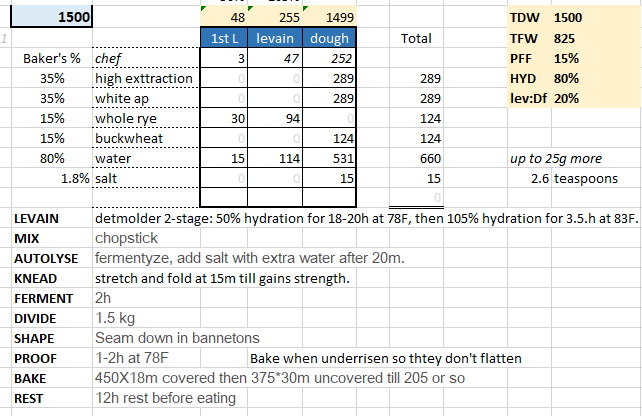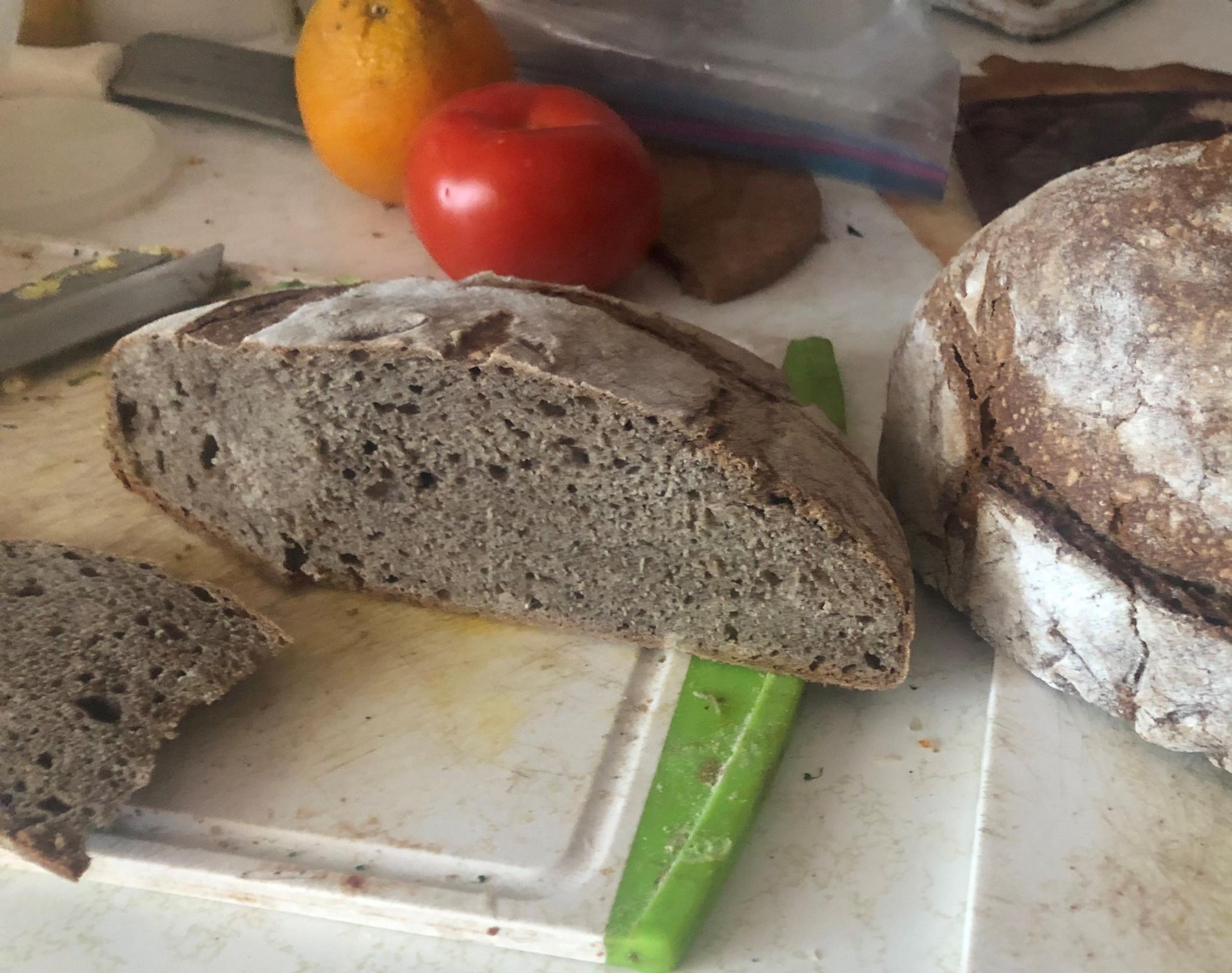
Buckwheat Miche

Hamelman's mixed grain miche from Bread 3rd ed. It's 15% buckwheat and 15% rye (the starter). A winner!
Formula

This was baked under an Arizona heat-wave, and the builds, bulk and proof all reflect that. Rather than elaborate the rye starter like Hamelman at 70F, I used the Detmolder 2-step process at 78-83F. (See here for my reasoning.) It worked great to leven the bread nicely without commercial yeast. But of course feel free to build the rye sour any way you're used to.
This is a really sticky dough, and hard to handle. I'm used to sticky wet wheat doughs--but this one is simply unpleasant. It took a heck of a lot of stretch and folds to build low degrees of strength, and, even with bassinage, it stuck to my fingers like cement. I didn't dare take it out of the container. Maybe I'll use the bread machine to mix next time. Or leave out the buckwheat till the wheat develops.
I substituted 50% white all purpose mixed with 50% Golden Buffalo for the T80 high extraction flour called for in Hamelman's recipe. Technically the Golden Buffalo is "high extraction" but it looks and tastes more like an ordinary whole wheat to me. If you want to follow the book literally, use all 578g of high extraction flour, or split it 50/50 white and whole wheat as Hamelman suggests.
The bread itself is delicious! But not for everyone--you have to like buckwheat. The buckwheat shines through with a sweet, earthy taste that dominates. Unexpectedly, considering it's mostly whole grain, the texture is very soft and chewy and springy, almost like a wonder bread. The rye and wheat are subtle in the background. Wouldn't want this every week, but a nice change of pace. (My son was less enamored with the buckwheat flavor.)
The 1500g miche is toward the flattish side, but not a pancake. I think it works great in the high-hydration "miche" form-- I didn't really want a higher loaf like I usually make. I think a loaf pan would work as well, since it has the texture of a sandwich loaf. I do recommend sticking to Hamelman's suggestion to go at least 80% hydration, since this bread benefits from the lightness even if it doesn't behave like a white tartine and even if it's not pleasant to mix.



Comments
Buckwheat makes such an interesting final product! I’ve used it for pancakes before, and they were almost lavender. Your loaf is lovely and sounds delicious!
This was my first bake with buckwheat flour, so I didn't have anything to compare with. (I do cook with the groats when I make kasha varnishkes, a classic eastern european comfort food.)
I think it's one of those flavors people either like or hate. My son looked puzzled trying a slice, not sure if he liked it or not. I think he'd agree with your word "interesting." I'm curious too if the stickiness of the flour was from the rye or the buckwheat.
I noticed some recipes toast the buckwheat flour first, so that's a whole other thing to try.
Both rye and buckwheat are very sticky to work with.
That’s it then. I just didn’t expect that with only 30% of them.
If you want to really taste the buckwheat then yes, toast the buckwheat flour first. Your miche looks really great.
Benny
I don’t think the toasted buckwheat world work well in this particular loaf. But Hamelman has another niche with toasted buckwheat and spelt that I might try.
I'm even thinking of trying an experimental "kashe varnishkes" bread with toasted buckwheat, rye, and caramelized onion.
Ooh, that's sounds yummy!
Buckwheat in small doses is a nice favor but it can be difficult to work with. Your bake looks great.
Ian
... to an all-purpose wheat dough at 5% or 10%. but even at 10% the dough is noticeably stickier than without it. It's a nice addition for a sourdough English muffin.